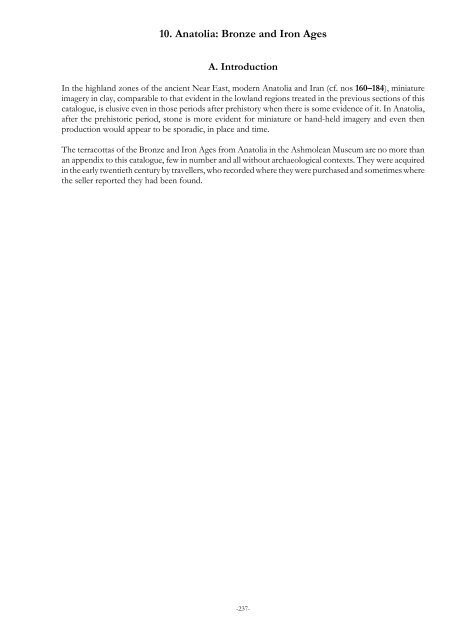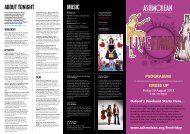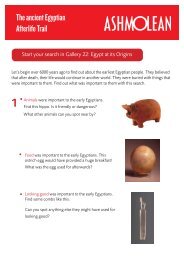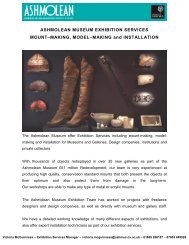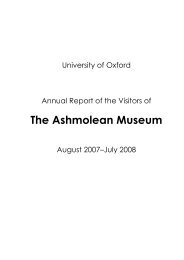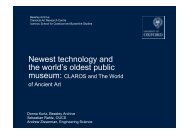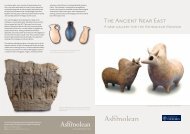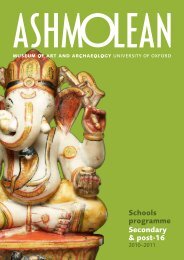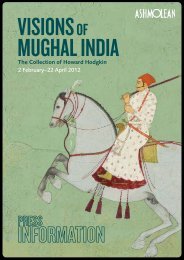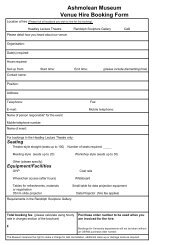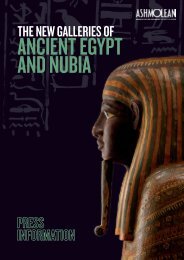Anatolia: Bronze and Iron Ages - The Ashmolean Museum
Anatolia: Bronze and Iron Ages - The Ashmolean Museum
Anatolia: Bronze and Iron Ages - The Ashmolean Museum
You also want an ePaper? Increase the reach of your titles
YUMPU automatically turns print PDFs into web optimized ePapers that Google loves.
10. <strong>Anatolia</strong>: <strong>Bronze</strong> <strong>and</strong> <strong>Iron</strong> <strong>Ages</strong><br />
A. Introduction<br />
In the highl<strong>and</strong> zones of the ancient Near East, modern <strong>Anatolia</strong> <strong>and</strong> Iran (cf. nos 160–184), miniature<br />
imagery in clay, comparable to that evident in the lowl<strong>and</strong> regions treated in the previous sections of this<br />
catalogue, is elusive even in those periods after prehistory when there is some evidence of it. In <strong>Anatolia</strong>,<br />
after the prehistoric period, stone is more evident for miniature or h<strong>and</strong>-held imagery <strong>and</strong> even then<br />
production would appear to be sporadic, in place <strong>and</strong> time.<br />
<strong>The</strong> terracottas of the <strong>Bronze</strong> <strong>and</strong> <strong>Iron</strong> <strong>Ages</strong> from <strong>Anatolia</strong> in the <strong>Ashmolean</strong> <strong>Museum</strong> are no more than<br />
an appendix to this catalogue, few in number <strong>and</strong> all without archaeological contexts. <strong>The</strong>y were acquired<br />
in the early twentieth century by travellers, who recorded where they were purchased <strong>and</strong> sometimes where<br />
the seller reported they had been found.<br />
-237-
ANCIENT NEAR EASTERN TERRACOTTAS<br />
-238-
(i) Early <strong>Bronze</strong> Age<br />
BRONZE AND IRON AGES: CATALOGUE – ANATOLIA<br />
<strong>Anatolia</strong>: <strong>Bronze</strong> <strong>and</strong> <strong>Iron</strong> <strong>Ages</strong><br />
B. Catalogue<br />
380. Female figurine; baked; h<strong>and</strong>modelled; brownish ochre fabric, highly burnished; the<br />
incised decoration is in deep cut lines made before firing <strong>and</strong> then filled with a white<br />
substance of which traces remain; flat, stylized form. As a deeply incised line separates<br />
it from the top of the head, the round flat object may be a cap rather than dressed hair.<br />
<strong>The</strong> back of the “cap” is elaborately patterned with chevrons in four quadrants, each<br />
b<strong>and</strong> marked with incised dots; the front has a zigzag line with dots alternating in the<br />
triangles. A similar pattern marks the hair across the brow. <strong>The</strong> eyebrows <strong>and</strong> nose are<br />
incised lines, with the eyes, a dot within a square, drawn away to the sides of the face, no<br />
mouth is clearly shown (a mark in the clay seems to be accidental) <strong>and</strong> no ears. <strong>The</strong>re is<br />
a necklace with linear pendants above crossing-straps, marked out with dots. On either<br />
side rises in the clay, indicating breasts, are overlaid with incised chevrons up to the arm stubs; the navel<br />
is indicated; there is a “girdle” with a design of chevrons, above the highly stylised genitals; at this point the<br />
figurine terminates in a curving line. On the reverse are two tassels, pendant from the “cap”, above<br />
crossing-straps depicted as on the front. It appears that the figure is nude.<br />
AN1910.669; H: 9.3cm W: 4.9cm. (Bought at Adalia [modern Antalya] on the south coast of Turkey by<br />
Hasluck <strong>and</strong> Woodward; “said to have been found at a depth of two metres from the surface at Chai-<br />
Kenar, near Istanoz, about twelve hours north-west of Adalia”.<br />
Peet 1909, 145–6, pl. XXVI; Bossert 1942, 44, pl. 85.<br />
381. Female Figurine (cf. no. 380 above); baked; h<strong>and</strong>modelled; brownish ochre fabric, highly<br />
burnished; the incised lines were deeply cut before firing <strong>and</strong> filled with a white substance<br />
of which traces remain; unlike no. 380 above the back is entirely plain. Triangular shaped<br />
head with dots to indicate the eyes, at the extremity of the face on each side, <strong>and</strong> the<br />
mouth, within a pattern of converging chevrons; necklace of dots with an upper <strong>and</strong> lower<br />
line. <strong>The</strong> remainder of the body is rendered just like no. 380 above, but the breasts are not<br />
indicated by rises in the clay.<br />
AN1910.668; (as no. 380 above) H: 8.2cm W: 3.8cm.<br />
Peet 1909, 146, pl. XXVII; Bossert 1942, 44, pl. 85.<br />
382. Worn fragment from the torso of a female figurine like nos 380 <strong>and</strong> 381<br />
above; h<strong>and</strong>modelled of pale buff, unburnished clay; baked; stub arms with<br />
incised chevrons over the breast area.<br />
AN1910.579 W: 3.9cm H: 2.3cm. “From Near Adalia: Mound of “Fugla”<br />
(finder’s note).<br />
<strong>The</strong>se two complete terracottas, <strong>and</strong> possibly the fragment, belong to a chance<br />
find at Çaykenari, betweeen Antalya <strong>and</strong> Hacilar, in the first decade of the twentieth century from which<br />
comparable figurines found their way into other museum collections (cf. van Loon et al. 1989,<br />
Zimmermann 1993, nos 56–62; Møller 1995, nos 16–19). Indeed, the whole category is now often referred<br />
to as the “Çaykenari Type”. Contemporary Early <strong>Bronze</strong> II (c.2700–2300 B.C.) dark-faced pottery is also<br />
decorated with incised necklaces, cross-b<strong>and</strong>s <strong>and</strong> dots evoking the recurrent close<br />
connection between anthropoid pottery shapes <strong>and</strong> terracotta figurines, both probably<br />
made by women.<br />
383. Nude female figurine; seated; h<strong>and</strong>modelled; baked; coarse buff fabric with a<br />
burnished red slip, worn off on the flat base; two holes are pierced in the lower back <strong>and</strong><br />
one in the centre of the base; the slightly damaged face was applied as a disk, tipped back<br />
so that the chin projects, on the front of the head; the eyebrows <strong>and</strong> nose are a<br />
continuous projecting ridge; the eyes are deep-punched holes in incised oval frames; the<br />
-239-
ANCIENT NEAR EASTERN TERRACOTTAS<br />
mouth is an incised slit with vertical incisions below on the chin (“beard”); the ears <strong>and</strong> what was originally<br />
a major protrusion (“polos”) on the head are broken off; the upper body is flattened, with triangular shape<br />
accentuated by projecting shoulders; attenuated arms extended down either side of the body with the h<strong>and</strong>s<br />
grasping the knees; incised lines on the upper arms <strong>and</strong> shoulders; incised crossing straps <strong>and</strong> what may be<br />
a necklace; pointed breasts with incised nipples; genitals represented by an incised rectangular with incised<br />
dots inside it; short lower body with stump legs.<br />
AN1910.697: H: 9.7cm. obtained at Izmir (“Smyrna”) by D.G. Hogarth as from the area of Thyateira<br />
(Akhisar: map in Korfmann 1979).<br />
Ormerod 1912–13, 54–5, fig. 3; Korfmann 1979, 190, 197, pl. 29; Obladen-Kauder 1996, 276, n.737).<br />
Three miniature vessels (AN1910.694–6) were acquired with this figurine; but there is no evidence of a<br />
direct association.<br />
Korfmann (1979) was the first to place this figurine in its chronological <strong>and</strong> cultural context by<br />
comparison with terracottas from Demircihüyük, to the north west of Akhisar, whence it was reported<br />
to have come. Akhisar is some thirty-five kilometres south of Yortan (east of Pergamon), where in 1901<br />
French archaeologists excavated an extra-mural cemetery yielding finely made pottery of Troy I–II type,<br />
comparable in some cases to the miniature vessels reported with this figurine. <strong>The</strong> parallel figurines at<br />
Demircihüyük, were attributed to levels L <strong>and</strong> K (Korfmann 1979, 187, 191; see now Obladen-Kauder<br />
1996). Surviving undamaged heads of comparable figurines from other west <strong>Anatolia</strong>n sites of the Early<br />
<strong>Bronze</strong> Age allow for reconstruction of a cylindrical projection at the back of the head, behind the diskshaped<br />
face (cf. Korfmann 1979, fig. 1: 1, 3; fig. 3,5,6). A very similar, more complete figure of the same<br />
seated type as no. 383 is illustrated as from Çikick, some two hundred <strong>and</strong> fifty kilometres east of Akhisar,<br />
by Korfmann (1979, fig. 6). It is difficult to establish whether the projection is a headdress or whether it<br />
is the hair dressed into a high knot, or a combination of the two (cf. Obladen-Kauder 1996, 267). <strong>The</strong>re<br />
is no certainty as to whether such figurines represented a goddess or a female member of the local<br />
community (cf. Obladen-Kauder 1996, 257–9). Korfmann (1979) identified her as a goddess.<br />
(ii) <strong>Iron</strong> Age<br />
384. Upper part of a warrior, broken off at the waist; baked; crudely modelled by h<strong>and</strong>;<br />
burnished, chocolate brown fabric wears a partly broken conical helmet or leather cap;<br />
pierced eyes; pointed nose; roughly indicated mouth, chin <strong>and</strong> beard; spear held in right<br />
h<strong>and</strong>, round shield with boss in left.<br />
AN1911.311 (“bought in the bazaar at Isbarta”, southwest Turkey) H: 6.9cm W: 3.3 cm.<br />
Ormerod 1912–13, 53–4, fig. 2a.<br />
This figurine is so crudely made that little may be said about it beyond an attribution to the<br />
mature <strong>Iron</strong> Age, when the warrior’s equipment is most readily paralleled; but whether it is<br />
of the Achaemenid Period, or somewhat earlier, is uncertain. <strong>The</strong>re are no obvious grounds for doubting<br />
its antiquity.<br />
385. Horse-rider: male; head detached from body when acquired; baked; h<strong>and</strong>modelled; coarse<br />
orange fabric with polished slip originally; head, nearly globular, has large ears, prominent eyes<br />
beneath arched brows, passing directly into a prominent straight-edged nose; mouth slightly<br />
indicated; chin damaged; wears a prominent “Phrygian” cap, depressed at the sides, with a<br />
high ridge front to back; the left arm <strong>and</strong> the right below the elbow are missing; the width <strong>and</strong><br />
distortion of the groin indicate that it was made to be mounted as a rider; the trunk of the<br />
body is a flattened cylinder; very worn surface, but simple geometric designs in black are still<br />
evident in traces on the top <strong>and</strong> sides of the back, indicating a garment; black is also still<br />
evident on the eyes <strong>and</strong> cap rim; at the base of the back is a broad triangular patch of brown<br />
colour. Myres (AN1903.399) thought this might indicate a “saddle”, of which there may also<br />
be painted traces at the front. It could, however, simple indicate the groin area of the costume.<br />
AN1909.943 (“from the Hammam or hot springs 1½ miles east of Keuhne, near the site of<br />
MITHRADATEION on the border between Galatia, Cappadocia, <strong>and</strong> Pontus... secured by Mr Anderson”<br />
(Myres 1903, 378–9); given by J.W. Crowfoot. H: 20.5cm. W: 6.3cm (base).<br />
-240
BRONZE AND IRON AGES: CATALOGUE – ANATOLIA<br />
"Keuhne Hammam”, on the central <strong>Anatolia</strong>n plateau east of Ankara is most likely to be the modern town<br />
of Sorgun, east of Yozgat on the road towards Sivas (Mason 1943, II, 457–8, fig. 104; Summers: personal<br />
communication). <strong>The</strong>re were once Roman baths there; but, so far nothing earlier has been reported <strong>and</strong><br />
there is said to be no sign of a tell. It is likely that the figure came from a site not too far distant from the<br />
place where it was bought; Kerkenes Dag has been suggested. <strong>The</strong> painted pottery of which it is<br />
manufactured relates it to the pottery of Alishar, where fragments of similarly painted terracotta statuettes<br />
were found (Von der Osten <strong>and</strong> Schmidt 1932, 38, frontispiece; Von der Osten 1937, 410, fig. 474: d<br />
1618). It may be dated to the period between about 650 <strong>and</strong> 550 B.C. If it is correctly identified as a<br />
horseman, it is an elaborate example of the rider type of figurine widely distributed across the Near East<br />
at this time.<br />
(iii) Roman (?)<br />
386. Quadruped; possibly a sheep; baked; h<strong>and</strong>-made; coarse red fabric with<br />
prominent grits; the surface is very worn, possibly rubbed down to smooth it;<br />
the two legs on the right side are broken off; the neck is extended forward with<br />
a triangular shaped head; ears, eyes <strong>and</strong> nostrils punched, gash for mouth; a<br />
series of linear characters are incised along the back after baking <strong>and</strong> after the<br />
surface was smoothed; others, more fresh looking in appearance run along the<br />
left flank. <strong>The</strong>y have in the past been identified as Cretan Linear A.<br />
AN1933.451 (Bequest of A.H. Sayce; attributed to “Old Samsun”, Pontus).<br />
A. Evans 1935, 768, fig. 749; Brice 1961, 23, pl. XXIX (as Linear A); Godart <strong>and</strong> Olivier 1982, XXI<br />
(regarded the inscription as non-Aegean <strong>and</strong> not Linear A.). In a personal communication Professor Anna<br />
Morpurgo Davies agreed with Godart <strong>and</strong> Oliviers’ conclusion. As the result of a thermoluminescence test<br />
of this animal “using st<strong>and</strong>ard methods <strong>and</strong> techniques it was estimated that the date of the last firing was<br />
between 1100 <strong>and</strong> 1700 years ago,” (Doreen Stoneham 1997). This suggests a date of manufacture in the<br />
first millennium A.D.<br />
If this figurine does indeed come from the reported area, it might be from the sanctuary of Zeus at Asar<br />
Tepesi in the hills between Gerze <strong>and</strong> Samsun, where a number of animal figurines have been reported<br />
(Isin 1998, 109, pl. 23: 4–5). Even so, the inscription would appear to be a recent addition, perhaps to<br />
increase its value on the antiquities market.<br />
-241-


